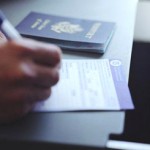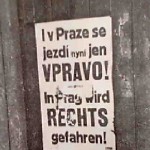
When I moved to live and work in the Czech Republic in September 2008, I believed I had a pretty good grasp of European History. I had studied the subject for many years at school and it was one of the three subjects I read, along with Geography and Theology, during my first year as an undergraduate student at university. However, during these past 16 months, my historical knowledge and understanding has been greatly increased as I’ve sought to understand the Czech people and this country which has become my current adopted home.
Good students of history do not just learn dates and places when and where certain events took place, such as knowing that the Battle of White Mountain occurred in 1620 on a hill just to the west of Prague. Rather they will want to understand the causes that led to the battle taking place and the consequences that followed from the victory of the Catholic League over the supporters of the Bohemian Estates. But a student still needs to know the dates and events before s/he can do any historical analysis.
During the last hundred years, the Czech and Slovak people have suffered much. Until 1918, they were a subjugated people incorporated into the Austro-Hungarian Empire. Then, having enjoyed twenty years as an independent democratic nation, their country was partly carved up without any consultation, by Neville Chamberlain and others at Munich. Six months later, the whole of Czechoslovakia was under Nazi occupation. Then, two and a half years after being liberated from the Nazis, the country was subjected to nearly forty-two years of Soviet inspired communist rule.
Under communist rule, many Czech and Slovak people suffered greatly. But it was not just people who suffered, another victim was historical truth.
Czechoslovakia has the distinction of being the country that endured the longest period of Nazi occupation. It was already fully occupied by March 1939 and was not liberated until the last days of World War Two in early May 1945. Liberation came from two different directions. Slovakia and Moravia and eventually Prague in Central Bohemia, were liberated from the east by the Soviet Red Army. But the whole of Western Bohemia, including the major city of Plzen, was liberated from the west by the Third US Army under General G.S. Patton.
After the Communist seizure of power at the beginning of 1948, there was a systematic campaign to suppress all acknowledgement of the U.S. Army’s role in liberating Western Bohemia. This effort continued until December 1989 when the Communists were removed from power. History textbooks declared that the whole of Czechoslovakia was freed from Nazi oppression by the valiant efforts of the Soviet Red Army. Schoolteachers were obliged to perpetuate the myth – to suggest otherwise would mean the loss of your job.
Last month, we drove out to Western Bohemia in order to visit our friend, Adrian Blank of Nepomuk, so he could carry out a couple of minor repairs to my car. But we combined the trip with a pastoral visit to one of our congregation who lives in a village very near to the German border but who regularly comes to Prague at weekends in order to worship at St. Clements.
Driving from Nepomuk towards the German border, we arrived in the attractive town of Klatovy where we stopped for lunch. We parked in the large square in the centre of the town which is surrounded by many architecturally interesting buildings including the Town Hall, pictured above. As we explored the square we saw two plaques, either side of a window on the outside of the Town Hall.

The first is only in Czech and reads in translation;
9th May 1945 the Soviet Army liberated Czechoslovakia
Unveiled as part of the celebrations of the 700th Anniversary of founding of the town of Klatovy
Klatovy was founded in 1260 so the plaque was presumably unveiled in 1960, twelve years into Communist rule.
Not only does the wording on the plaque perpetuate the myth that it was the Soviet Red Army that liberated the whole of Czechoslovakia, it also includes another little Soviet quirk. The German surrender that brought World War Two to an end in Europe came into effect late on 8th May 1945. This became known as VE Day (Victory in Europe Day) and is a public holiday in many Western European countries such as France. But because it was late on 8th May in France and Germany, it was already past midnight in Moscow. Therefore as far as the Soviet communists were concerned, VE Day was 9th May 1945! Since the Velvet Revolution, the VE Day public holiday is now marked on 8th May each year in the Czech Republic, not 9th May.
On the other side of the window is a second plaque, pictured below, with text in both Czech and English. Although not dated, it has clearly been put up since 1989.

With this second plaque, the facts of Czech history have been corrected. Klatovy was liberated on 5th May 1945 by the US Third Army under General Patton. The following day, they moved on and liberated Plzen.
What I was most struck by was the fact that the Town Council had obviously decided not to take down and destroy the first incorrect plaque. They clearly felt that it was important to preserve it as a historical record of the Communist era. But the truth has eventually triumphed and is now clearly displayed for all to read. Much as many people would like to, especially Communist dictatorships, you cannot re-write history.




I agree with you that it is important that the council have preserved the original plaque, for although it is untrue in its statement of the facts about the liberation it reveals much about the nature of the Communist state. The ‘legitimacy’ of the Soviet puppet states of Eastern Europe was based on the idea that the Red Army had ‘liberated’ them from the Nazis – only, of course, to replace them with equally loathsome regimes.
I wonder what the people of Klatovy made of the statement that they had been liberated by the Red Army, when, presumably, many of them would have remembered the Americans arriving. And of course the fact that Czechoslovakia was again ‘liberated’ from counter-revolutionary elements by the arrival of tanks in 1968.
One is reminded of Orwell’s phrase that ‘He who controls the present, controls the past. He who controls the past, controls the future.’But it is not just in totalitarian states that this rewriting of history takes place. Hollywood has skewed the way many people have perceived history.
The Western is perhaps the most obvious example, which until recently, suggested a history of the interaction between the indigenous peoples and the white colonialists which bore only the most fleeting of relationship to the facts. And don’t get British war veterans started on Hollywood movies about the Second World War in which you would be hard put to know that Britain had even been involved.This is not a state controlled attempt to alter history but in many ways its effect is just as invidious.
Many thanks for the blog and congratulations on your first year.
Tim – Thank you for your most thoughtful comment.
Of course the people of Western Bohemia knew all through the communist era, that it was the US Army, not the Soviet Red Army, that had liberated them from Nazi occupation. The Americans left behind much physical evidence such as military hardware, which was either damaged or not deemed worthwhile transporting back across the Atlantic. Thus US Army jeeps and the like were hidden away in farm buildings and garages and lovingly repaired and preserved, out of sight of the communist authorities.
Since 1990, each year during the early part of May, the Czech owners of these WW2 US Army vehicles bring them out and drive them in parades through different Western Bohemian towns, celebrating the anniversary of their liberation from Nazi occupation. Some owners drive around quite regularly in them. I actually saw a US Army WW2 Jeep parked in the centre of Prague today!
Your comments about how Hollywood has so easily skewed the way many people perceive history are extremely insightful and accurate. The former communist authorities in Central & Eastern Europe were not the only ones doing it during the last century!
I’m glad you enjoy the blog. Please keep visiting and commenting!
Yep, my wife’s grandfather was proud to have met the Americans. No-one was fooled by the change of history – they even tried to teach it in schools 🙂
Last weekend in Plzen and through the week there were all the old jeeps about – fun following halftracks through the little roads!
Think in Zinkovy Castle they set up camp for some time at the end of WW2 – so around here in Nepomuk we know about them.
Hi Adrian – Many thanks for visiting my blog once more and leaving your comment. You did get a personal plug in this post as you have in one or two previous ones!
An American member of my congregation missed Church last Sunday in order to be at one of the parades in Plzen to commemorate the 65th anniversary of the liberation of West Bohemia by the American forces in early May 1945. And the British Ambassador told me a few weeks ago that she has been invited to umteen wreath laying ceremonies in your part of the Czech Republic, to mark the 65th anniversary of liberation from the Nazis.
Thanks very much for your description of your stop in Klatovy and the correcting of historical distortions promoted by the Communist government of Czechoslovakia. My wife’s ancestors emigrated from Klatovy to America in the mid 19th century. Both of us had relatives in Gen. Patton’s Third Army who might have been involved in the liberation of Western Bohemia. We hope to travel to this region in the future.
Mike – With all those interesting associations, you certainly should travel and visit Western Bohemia. It is scenically beautiful and anyone with family connections or General Patton’s Third Army connections is made very welcome.